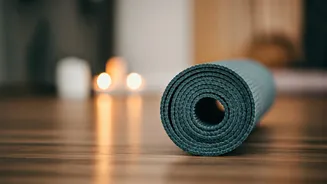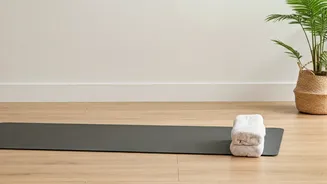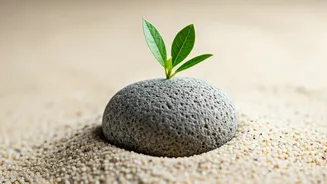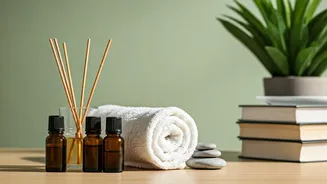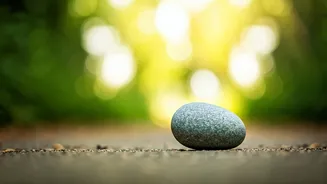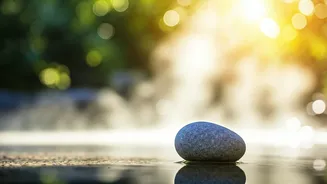Introduction to Yoga
Yoga, an ancient practice, is often associated with physical postures, or asanas. However, its true essence lies in the integration of mind, body, and
spirit. When dealing with anxiety, specific yoga poses can work wonders. These poses are designed to calm the nervous system, reduce stress hormones, and promote a sense of relaxation. Practicing yoga regularly can lead to improved mental clarity and emotional resilience. It is a readily available tool to manage the physical and mental symptoms associated with anxiety. This practice can be integrated into daily life, requiring minimal equipment and space. Incorporating yoga into your routine can be an empowering step towards taking control of your well-being.
The Child's Pose
The Child's Pose, or Balasana, is a comforting posture that brings immediate tranquility. To perform this pose, start by kneeling on the floor with your knees hip-width apart and your big toes touching. Gently lean forward, resting your torso on your thighs and your forehead on the floor. Extend your arms forward or rest them alongside your body. This pose gently stretches the hips, thighs, and ankles, while calming the brain and relieving stress and fatigue. It is a restorative pose, often used as a resting point between other asanas. In this position, deep, calming breaths can be taken, allowing you to connect with your breath and foster a sense of grounding. It's a great choice for whenever anxiety symptoms begin to surge.
Standing Forward Bend
Uttanasana, or the Standing Forward Bend, is another pose that can bring a sense of calm. Begin by standing with your feet hip-width apart. Inhale and reach your arms overhead. Exhale and bend forward from your hips, keeping your knees slightly bent to protect your lower back. Let your head and neck relax, allowing gravity to gently stretch your spine. This pose calms the brain and helps relieve stress and mild depression. The gentle inversion can improve circulation and reduce fatigue. It is a simple yet powerful way to release tension and promote relaxation. Focus on your breath, inhaling to lengthen your spine, and exhaling to deepen the stretch. Maintain the pose for several breaths to receive its full benefits.
Corpse Pose
Savasana, or Corpse Pose, is the ultimate relaxation pose, often done at the end of a yoga session. Lie flat on your back with your legs extended and your arms by your sides, palms facing up. Close your eyes and allow your body to completely relax. Focus on your breath and progressively relax each part of your body, from your toes to the top of your head. This pose calms the brain and helps relieve stress and mild depression. It allows the body and mind to completely unwind, fostering a deep state of relaxation. During this time, let go of any tension, worries, or thoughts. Savasana can be practiced for 5 to 15 minutes, allowing you to recharge and rejuvenate. It is the perfect conclusion to any yoga routine.
Breathing Exercises
Incorporating breathing exercises, or pranayama, into your yoga practice can significantly reduce anxiety. Deep, controlled breathing activates the parasympathetic nervous system, responsible for the body's relaxation response. The 4-7-8 breathing technique, for example, involves inhaling for a count of four, holding your breath for a count of seven, and exhaling slowly for a count of eight. Diaphragmatic breathing, where you focus on expanding your abdomen as you inhale, can also be highly effective. These techniques can be done anywhere, anytime, providing an instant tool for managing anxiety symptoms. Practicing breathing exercises regularly can improve your ability to cope with stressful situations. Combine breathing exercises with yoga poses for enhanced stress reduction.
Tips for Beginners
If you're new to yoga, start slowly and listen to your body. Begin with gentle poses and gradually increase the intensity and duration as you become more comfortable. There are many online resources and videos suitable for beginners. Choose a quiet space, free from distractions, where you can focus on your practice. Wear comfortable clothing that allows for free movement. Always warm up your body before practicing yoga. Focus on your breath and the present moment, letting go of any judgment or self-criticism. Consistent practice is the key to reaping the benefits of yoga. Remember that everyone's body is different, so adapt the poses as needed to accommodate your physical limitations.
Yoga with Professional Guidance
While yoga can be practiced independently, attending a class led by a qualified instructor can be beneficial, especially for beginners. A yoga instructor can provide guidance, correct your form, and modify poses to suit your needs. They can also offer valuable insights into the philosophy and practice of yoga. Look for a class that caters to your skill level. Many studios offer beginner-friendly classes focused on stress reduction and relaxation. Taking classes allows you to connect with a community of like-minded individuals, fostering a sense of support and encouragement. The presence of a teacher can enhance your practice and ensure you are performing the poses safely and effectively. Consider exploring different styles of yoga, such as Hatha or restorative yoga, to find what resonates best.
